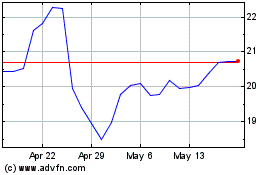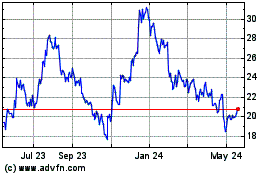Barring an expected slowdown in loan growth, U.S. banks appear well
placed to perform steadily through the remainder of 2012 on
uninterrupted expense control and a contraction in provisions for
credit losses. At least the progress seen in the first half of the
year gives us this indication.
Marked recovery of the bond and equity markets and consequent
revenue growth pushed the first quarter results a bit higher than
expected, but the second quarter failed to impress with respect to
top-line growth due to a decelerating economy. A combination of
factors -- subdued federal spending, ongoing European crisis and
tax law uncertainty following the presidential election -- kept
revenue and trading income under pressure. However, core dynamics
showed strength throughout the first half.
Moreover, U.S. banks are actively responding to every legal and
regulatory pressure, indicating the fact that they are well
positioned to encounter impending challenges. In addition, taking
advantage of the growing demand for loans from large- and
medium-sized businesses, U.S. banks have been easing their lending
standards in order to boost loan growth.
However, the potency of the sector is not expected to return to its
pre-recession peak anytime soon. The economic intricacies, both
domestic and overseas, may even result in further disappointments
in the upcoming quarters.
A decelerating growth rate of the U.S. gross domestic product (GDP)
(annualized growth came in at 1.5% in the second quarter of 2012,
slowing sharply from 2% in the first quarter and 4.1% in the fourth
quarter of 2011) and slowing demand from businesses related to
real-estate will continue to restrict revenue growth.
Also, as the sector is undergoing a radical structural change, it
will witness continuous headwinds related to business expansion and
investor confidence. But entering the new capital regime will
ensure stability and security in the industry over the long
term.
Looking back, the government undertook several steps, including
capital injections and debt guarantees, to rescue the U.S. banks
from the effects of the financial crisis in 2008 and 2009. The
banks are also working hard since then to address problem credit,
primarily in residential and commercial real estate. Though
financial support from the government and banks’ efforts ultimately
transformed into stability, the sector has a long way to go before
bouncing back to its pre-recession glory.
Along with increasing earnings, a major recovery in the asset
markets, improving balance sheets and declining credit costs
promise growth for the U.S. banking sector, though at a
slower-than-normal pace. The dampening factors -- issues related to
the mortgage liabilities, asset-quality troubles, weak loan growth
and the impact of tighter regulations and policy changes -- are
expected to remain tied to the fate of the U.S. banks in the
upcoming quarters.
Profitability Remains Challenged
Though reduced loss provisioning has helped the industry witness
strong earnings growth over the last couple of years, we don’t
expect a significant pickup in the upcoming earnings from provision
reductions, as the difference between loss provisions and
charge-offs is gradually decreasing.
Banks will definitely try to look at other areas -- interest
income, non-interest income and operating costs -- to keep the
earnings growth intact, but there is no significant opportunity
that can boost top-line growth in the upcoming quarters.
Interest income will remain under pressure due to low interest
rates and sluggish loan growth. After accelerating for 10 straight
months, loan growth slowed in July 2012 and is expected to continue
falling in the coming months due to a feeble macro economy. Though
banks will try to cut interest expenses and take additional risks
to improve net interest margins, the flattening of the yield curve
will mar these efforts.
Ultimately, banks will be forced to face lower margins. In fact, if
the banks shift assets to longer maturities to keep net interest
margin strong, this could backfire once interest rates start
rising.
On the other hand, attempts to boost revenues through non-interest
sources -- introducing prepaid cards, imposing new fees, increasing
minimum balance requirements on deposit accounts and encouraging
customers to use credit cards -- could be hampered by ongoing
regulatory actions, a volatile global economy and soaring overhead.
So, non-interest income will be able to marginally contribute to
total revenue.
Lower revenue will finally force these banks to cut costs in order
to stay afloat. As a result, banks will continue cutting jobs and
reducing the size of operations by selling non-core assets. So, any
cost-cutting measure will act as a defense.
Balance Sheet Recovery to Take Time
Since last year, banks have been trying to address asset-quality
troubles through the disposition of nonperforming assets. Also,
non-core asset shedding has become an industry trend as banks have
no other alternative but to keep capital ratios above regulatory
requirements.
This non-core asset-selling, along with elevated charge-offs and
weak demand, will likely keep loan growth under pressure in the
near to mid-term. Moreover, heightened regulatory restrictions and
soaring delinquency rates will act as headwinds. However, banks
will experience steady deposit growth due to the lack of low-risk
investment opportunities following the global economic turmoil and
volatility in equity markets.
So we don’t expect a significant strength in balance sheets to
return anytime soon.
Regulatory Threats Lingering
Following the latest recession, the regulatory environment has
become tougher and costlier for U.S. banks. In the last several
quarters, banks had to face a number of regulatory requirements
under several laws, including Dodd-Frank legislation, the Durbin
Amendment and the Volcker Rule.
Many other regulatory requirements are expected to hinder growth in
the upcoming quarters as regulators focus on global alignment.
Though the aim is to meaningfully change the business models of
banks to make them self-sufficient over the longer term, the cost
of compliance will drag down profitability in the near- to
mid-term.
While the implementation of the Basel III requirements will boost
minimum capital standards, there will be a short-term negative
impact on the financials of U.S. banks as they will have to adjust
their liquidity management processes. But a greater capital cushion
for the larger banks will add to their ability to withstand
internal and external shocks in the long run. However, banks will
get the time to strengthen their capital position as the Basel III
requirements will be gradually introduced during the 2013 to 2019
period.
Macroeconomic Headwinds
There are several macroeconomic factors that may weigh on the
profitability of the U.S. banks. The most crucial among these is
the uncertain outlook for the U.S. economy.
Though improved economic data such as steady consumer spending and
relatively lower unemployment point towards optimism, the economy
has witnessed a lot less momentum in the first half of 2012 than
was anticipated. Concerns have crept up in the slothful stock
market, exacerbated by ongoing concerns related to the European
debt crisis.
Though the U.S. commercial banks appear to have significant direct
and indirect exposure to Europe, the potential costs are expected
to be manageable. However, if the crisis deepens, there will be
significant impact on worldwide capital markets, and the U.S. will
not be left unscathed. Consequently, U.S. banks would then face
increased challenges.
On the other hand, the extremely low interest-rate environment is
another manifestation of this uncertain macro backdrop. Concerns
about European finances and soft U.S. growth prospects have made
treasury instruments the choice of safe asset class. As a result,
yields on benchmark treasury bonds have hovered at low levels.
Bank Failures Continue
While the financials of a few large banks are stabilizing on the
back of economic stability and increasing dependence on noninterest
revenue sources, the industry is still on shaky ground. The sector
presents a picture similar to that of 2011, with nagging issues
like depressed home prices, still-high loan defaults and
unemployment levels troubling such institutions.
The lingering economic uncertainty and its effects also weigh on
many banks. The need to absorb bad loans offered during the credit
explosion has made these banks susceptible to severe problems.
Furthermore, government efforts have not succeeded in restoring
lending activity at the banks. Banks are also trying to boost
lending activity by easing lending standards, but sufficient loan
growth is not expected anytime soon given the weak real-estate
market. Lower lending will continue to hurt margins, though
the low interest rate environment should be beneficial to banks
with a liability-sensitive balance sheet.
Increasing loan losses on commercial real estate could trigger many
more bank failures in the upcoming years. However, considering the
moderate pace of bank failures, the 2012 number is not expected to
exceed the 2011 tally. From 2012 through 2016, bank failures are
estimated to cost the Federal Deposit Insurance Corporation (FDIC)
about $12 billion.
Eventually, the strong banks will continue to take advantage of
strategic opportunities, with the big fish eating the little
ones.
Conclusion
Clearly, the banking system is still not out of the woods, as there
are several nagging issues that need to be addressed. Banks will
also have to stay away from risky activities for immediate
benefit.
Given the progress in the industry so far, it seems that banks may
encounter several disappointments ahead before gaining investors’
confidence. In fact, the negatives could offset the positive
developments to a great extent.
OPPORTUNITIES
The regulatory requirement of focusing on banking institutions
toward higher-quality capital will help banks absorb big losses.
Though this would somewhat limit the profitability of banks, a
proper implementation would bring stability to the overall sector
and hopefully keep bank failures in check.
Specific banks that we like with a Zacks #1 Rank (short-term Strong
Buy rating) include
Enterprise Financial Services
Corp. (EFSC),
Heartland Financial USA
Inc. (HTLF),
Taylor Capital Group Inc.
(TAYC),
Access National Corp. (ANCX),
Community Trust Bancorp Inc. (CTBI),
First
Bancorp (FBP),
BofI Holding Inc. (BOFI),
North Valley Bancorp (NOVB),
Premierwest
Bancorp (PWRT),
Eagle Bancorp, Inc.
(EGBN),
Horizon Bancorp. (HBNC) and
United
Financial Bancorp, Inc. (UBNK).
There are currently a number of stocks in the U.S. banking universe
with a Zacks #2 Rank (short-term Buy rating). These include
Huntington Bancshares Incorporated (HBAN),
Old National Bancorp. (ONB),
Regions
Financial Corp. (RF),
Fidelity Southern
Corporation (LION),
TriCo Bancshares
(TCBK),
Central Pacific Financial Corp. (CPF),
Bank of Hawaii Corporation (BOH),
Community Bank System Inc. (CBU),
First
Commonwealth Financial Corp. (FCF),
Signature
Bank (SBNY),
Washington Trust Bancorp
Inc. (WASH),
BOK Financial Corporation
(BOKF),
Texas Capital BancShares Inc. (TCBI),
Fifth Third Bancorp (FITB),
KeyCorp (KEY),
M&T Bank
Corporation (MTB) and
U.S. Bancorp (USB).
WEAKNESSES
The financial system is going through massive deleveraging, and
banks in particular have lower leverage. The implication for banks
is that profitability metrics (like returns on equity and return on
assets) will be under pressure.
There are currently four stocks with a Zacks #5 Rank (short-term
Strong Sell rating). These are
Seacoast Banking Corp. of
Florida (SBCF),
Washington Banking Co.
(WBCO),
Hudson Valley Holding Corp. (HVB) and
International Bancshares Corporation (IBOC).
ACCESS NATL CP (ANCX): Free Stock Analysis Report
BOFI HLDG INC (BOFI): Free Stock Analysis Report
COMMUN TRUST BC (CTBI): Free Stock Analysis Report
ENTERPRISE FINL (EFSC): Free Stock Analysis Report
EAGLE BCP INC (EGBN): Free Stock Analysis Report
FIRST BNCRP P R (FBP): Free Stock Analysis Report
HUNTINGTON BANC (HBAN): Free Stock Analysis Report
HORIZON BNCP-IN (HBNC): Free Stock Analysis Report
HEARTLAND FINCL (HTLF): Free Stock Analysis Report
NORTH VALLEY BC (NOVB): Free Stock Analysis Report
OLD NATL BCP (ONB): Free Stock Analysis Report
TAYLOR CAP GRP (TAYC): Free Stock Analysis Report
UTD FINL BCP (UBNK): Free Stock Analysis Report
To read this article on Zacks.com click here.
Eagle Bancorp (NASDAQ:EGBN)
Historical Stock Chart
From Jun 2024 to Jul 2024

Eagle Bancorp (NASDAQ:EGBN)
Historical Stock Chart
From Jul 2023 to Jul 2024
